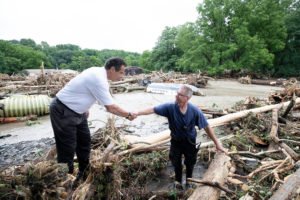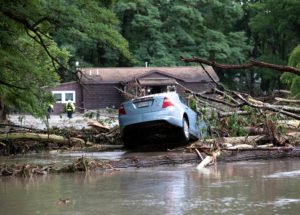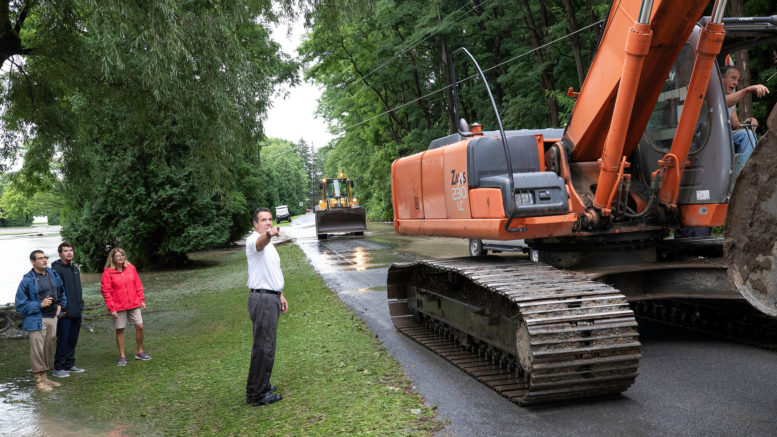
Governor Cuomo surveys storm damage and holds press briefing in Lodi, N.Y. Photo provided by the Office of Governor Andrew Cuomo.
Governor Andrew M. Cuomo today directed agencies specializing in disaster recovery and clean-up to the Finger Lakes and Southern Tier regions to assist counties after heavy rains and flash flooding moved through the area causing damage to roads, bridges, homes and other critical infrastructure.
At the Governor’s direction, Director of State Operations Cathy Calhoun has been deployed to Broome and Seneca counties today, and the Department of Financial Services will deploy its Mobile Command Center to assist residents with the insurance claims process.
The National Guard has deployed 50 personnel and is staging an additional 150 personnel for deployment to assist local governments with debris removal and cleanup. Damage assessment teams specializing in engineering and structural assessments from the Department of Transportation will be operating in the Southern Tier and Finger Lakes regions to evaluate roads, bridges and other infrastructure for damage and safety concerns.

Governor Cuomo surveys storm damage and holds press briefing in Lodi, N.Y. Photo provided by the Office of Governor Andrew Cuomo.
“With more rain expected this weekend, I am urging residents to be cautious at home and when traveling while roads and other infrastructure remain saturated and vulnerable,” Governor Cuomo said, adding, “We are capitalizing on this break in weather to mobilize recovery and clean-up personnel quickly in order to assess the storm’s impacts, and state agencies will continue to work with local officials to clear debris and assist in recovery efforts until the job is done.”
The Binghamton area is serving as the staging and coordination point for state assets for rapid deployment. Currently, 15 Department of Environmental Conservation Division of Environmental Remediation, Division of Water, and Operations and Permits staff are operating out of Binghamton and are assisting with flood response efforts.
Department of Transportation resources currently available in Binghamton include two vacuum trucks with sewer jets; one trailer-mounted sewer jet, and two water tankers. DOT also has available five traffic signal trucks, one tree crew bucket trucks, eight chippers, 133 large dump trucks, 33 large loaders, five grapple attachments, one grader, five wheeled excavators and six track excavators.
Additional assets deployed to Binghamton include, three Vac-Con crews made up of four employees, one sewer jet and one dump truck each. One Grade-All team, which includes six employees, four dump trucks, one excavator, and one loader.
Additionally, two pick-up sweepers with operators, and two dumps trucks with 2,600-gallon slide in water tanks plus operators have been deployed. A tractor trailer with water tanker and an operator have also deployed.
DHSES Office of Fire Prevention and Control has one high axle vehicle and one light medium tactical vehicle staged in Binghamton. Deployed personnel are comprised of four Fire Protection Specialists, four NY Task Force-2 team members, and one Deputy Chief.
State Police have staged at least 30 troopers in Troop C Endwell, as well as three airboats, two Zodiacs, and three four-wheel drive Utility Task Vehicles.
Binghamton Stockpile assets include:
- 60 generators
- 4 light towers
- 2 sandbaggers
- 100,000 sandbags
- 129 pumps of various sizes
A toll-free hotline is available for updates on DEC spill information, septic wells and health information, and for issues related to insurance. New Yorkers can reach the Flood Assistance hotline at 866-697-2434 for assistance.
Additional State Agency Actions
The New York State Emergency Operations Center in Albany continues to operate at Level 3 with additional personnel to assist with coordination of response and recovery efforts. DHSES’ Office of Emergency Management continues to operate in impacted areas and is in constant communication with county emergency management officials.
The State’s ten regional stockpiles are prepared with 18 sandbagging machines, over 1.8 million sandbags, over 700 generators, over 1,200 pumps and various hoses, 181 light towers, 960 traffic barriers, 594 traffic barrels, over 6,700 feet of aquadam temporary damming system, over 51,000 ready to eat meals and over 425,000 bottles and cans of water. The Division’s swift water rescue team: New York Task Force-2, Urban Search and Rescue Team, boats, and high axle vehicles are prepared for deployment.
The Department of Transportation is actively engaged in regions affected by flooding. Resources include 16 vacuum trucks with sewer jets; six trailer-mounted sewer jets, 11 water pumps and 14 water tankers.
DOT also has available 55 traffic signal trucks, 14 tree crew bucket trucks, 80 chippers, 1,323 large dump trucks, 307 large loaders, 45 grapple attachments, 19 graders, four bulldozers, 43 wheeled excavators and 38 track excavators.
Six teams, comprised of approximately 35 DOT personnel, have been deployed from around the state to Seneca County and Binghamton to help clear sediment and debris from culverts and closed drainage systems, haul debris away and assess damage. While water continues to recede, staff is standing by to repair damage so affected roads and bridges can be reopened as quickly as possible. DOT executive staff have been deployed to help manage operations in the affected regions, and 21 damage assessment teams are active in the state and local systems.
State Police have deployed 20 troopers, including divers and two canine units, for relief efforts in Seneca County, as well as two boats, three four-wheel drive Utility Task Vehicles, and an incident command vehicle. All equipment in other affected regions is staged and ready for deployment, including boats and 4×4 vehicles.
The Department of Environmental Conservation is continuing to deploy flood control assets to impacted communities. Currently, an estimated 75 DEC staff, including Emergency Management staff, Environmental Conservation Police Officers (ECOs), Forest Rangers, Division of Water staff, Regional Directors, Spill Responders, Environmental Remediation, and other staff are deployed across impacted communities. Four Air Boats and teams were deployed to Cortland to assist with rescue efforts.
At Seneca Lake, DEC Safe Boats, Tuff Boats, and ATVs and a UTV are staged to assist with ECO Rescue Task Forces. DEC Division of Environmental Remediation staff are responding as needed to assess potential flood damage and assist with clean up, and Division of Water and Operations staff are working with municipalities to check on dams, levees, and other impoundments.
In addition, DEC Forest Ranger hoist operators and swift water rescue teams have been deployed to Southern Tier counties to assist with ongoing rescue operations. DEC drones and drone operators are also assisting with recovery efforts.
DEC continues to secure floating and loose propane tanks, monitor wastewater treatment plants in the area, and inspect dams and flood control projects to ensure operational readiness. DEC Regional Directors are in close communication with municipal officials monitoring flood gauges, and DEC’s Division of Water ‘flood hub’ is actively monitoring the area. In addition, ECOs and Forest Rangers are patrolling impacted areas, coordinating with local officials, and responding as necessary.
New York State Thruway Authority staff continue to inspect drainage systems and remove debris along the roadway, as necessary. Additional staff are ready to assist with the deployment of equipment and resources if any flooding issues develop.
New York State Parks continues to actively monitor the situation and has directed the Park Police and park personnel to take appropriate action to prepare for possible flooding at State Park facilities, including clearing culverts and drainage areas and preparing equipment that may be necessary to respond to flood-related issues.
Park Police and Marine Services Navigational Aids are actively engaged in emergency response. Park patrons should monitor www.parks.ny.gov or call their local park office for the latest updates regarding park hours, openings and closings.
Yesterday’s storms triggered rescue operations from local and state first responders and caused widespread damage in many communities in these regions. DHSES’ Office of Fire Prevention and Control swift water rescue operating in Seneca County assisted 77 people with evacuations in addition to checking 89 structures for individuals needing help. In addition, the Department of Environmental Conservation performed ten air boat rescues in the town of Conklin in Broome County.
The State Emergency Operations Center continues to operate at a Level 3 to coordinate any response and recovery efforts in impacted counties. Regional emergency response teams are activated and are in close contact with community leaders and emergency responders.
The Division of Homeland Security and Emergency Services, Department of Transportation, Division of Military and Naval Affairs, Thruway Authority, Department of Environmental Conservation, State Parks, and State Police are mobilizing resources and personnel for recovery efforts from heavy downpours in areas that that have experienced an abundance of recent rainstorms.
A much-needed break in the weather is expected today before rain resumes this weekend. Rain will return to already saturated areas of the Southern Tier and Finger Lakes Thursday evening into Friday, and the National Weather Service may issue Flood and Flash Flood watches and warnings in the next few days. For a detailed list of weather watches and warnings, visit the National Weather Service website.
Stay Informed
At the Governor’s direction, New York State has recently improved the NY-Alert emergency alerting system. NY-Alert warns citizens of critical information and emergencies and provides timely information to protect lives. Warnings and emergency information can be directed to a phone call, email, text message or fax. Visit alert.ny.gov for more information.
If you have experienced flooding
- Walls, hard-surfaced floors and many other household surfaces must be cleaned with soap and water and disinfected with a solution of 1 cup of bleach to five gallons of water.
- Thoroughly disinfect surfaces that come in contact with food and children’s play areas.
- Wash all linens and clothing in hot water or dry-clean.
- Items that cannot be washed or dry-cleaned, such as mattresses and upholstered furniture, must be air dried in the sun and sprayed thoroughly with a disinfectant.
- Steam-clean all carpeting.
- Replace fiberboard, insulation and disposable filters in your heating/cooling system.
- Wear rubber boots and waterproof gloves during clean-up.
- It can be difficult to throw away items in a home, particularly those with sentimental value. However, keeping certain items soaked by sewage or floodwaters may be unhealthy. Materials that cannot be thoroughly cleaned and dried within 24-48 hours should be discarded.
Preventing the Growth of Mold
- Moisture that enters buildings from leaks or flooding accelerates mold growth. Molds can cause disease, trigger allergic reactions and continue to damage materials after the storm.
- Remove standing water from your home or office. Remove wet materials promptly and ventilate; use fans and dehumidifiers if possible.
- If mold growth has already occurred, it is best to have a professional remove it.
- Individuals with known mold allergies or asthma should never clean or remove mold.
- Be careful about mixing household cleaners and disinfectants, as combining certain types of products can produce toxic fumes and result in injury or death.
For more safety tips for all types of weather events, visit the DHSES website at www.dhses.ny.gov/oem/



Be the first to comment on "Governor Cuomo directs recovery teams to the Southern Tier Region and the Finger Lakes"